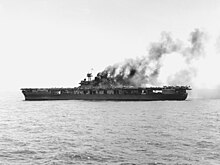USS Yorktown (CV-5)
 USS Yorktown, 1937 |
|
| Overview | |
|---|---|
| Shipyard | |
| Keel laying | May 21, 1934 |
| Launch | April 4, 1936 |
| 1. Period of service |
|
| Commissioning | September 30, 1937 |
| Whereabouts | sunk on June 7, 1942 |
| Technical specifications | |
| displacement |
25,500 ts |
| length |
247 m |
| width |
33 m |
| Draft |
8.5 m |
| crew |
1889 (peacetime) |
| drive |
four propeller with Parsons turbine drive |
| speed |
32.5 knots |
| Range |
10,400 nm at 15 knots |
| Armament |
|
| radar |
|
| Planes |
96 max., 80-90 were on board |
The USS Yorktown (CV-5) was an aircraft carrier and the lead ship of the class of the same name . The third US Navy ship with this name entered service in 1937 and was used against Japan in the Pacific War during World War II . The carrier, also known as the "Fighting Lady", took part in the Battle of the Coral Sea in May 1942 and was sunk in June 1942 during the Battle of Midway .
history
The USS Yorktown , named after the Battle of Yorktown , was laid down on May 21, 1934. The launch took place on April 4, 1936 and the handover to the Navy took place on September 30, 1937.
The USS Yorktown was actually the result of the Washington Naval Conferences on Disarmament , which were held between the United States , Great Britain , Japan , France and Italy in 1921/22 . The agreement allowed the USA 135,000 tons for the entire aircraft carrier fleet. The first three carriers built, the USS Langley , USS Lexington, and USS Saratoga , were converted ships of other classes. The USS Ranger was the first carrier that was planned as such.
As Franklin D. Roosevelt in 1933 the New Deal announced were in the budget dollars and 40 million for two new aircraft carriers provided for the defense. The USS Enterprise was laid down on July 16, 1934, and her sister ship, the USS Yorktown , two months earlier.
The maiden voyage took the USS Yorktown to Puerto Rico , Saint Thomas in the American Virgin Islands , Haiti and the Panama Canal zone in January 1938 . After short-term repairs, she took part in her first combat exercise in the Atlantic in early 1939 . After her crossing into the Pacific at the end of April 1940, the second exercise took place there.
Since the threat posed by German submarines in the Atlantic increased steadily in the spring of 1941 , the US fleet command decided to relocate a strong unit, to which the USS Yorktown also belonged, to the Atlantic (→ American neutrality patrol ). The mission lasted until the beginning of December that year when the USS Yorktown went to Norfolk for overhaul work .
When the Japanese attacked Pearl Harbor on December 7, 1941 , only the aircraft carriers USS Enterprise , USS Lexington and USS Saratoga were in the Pacific, while the USS Ranger , USS Wasp and the newly commissioned USS Hornet were operating in the Atlantic.
The USS Yorktown entered San Diego in late December 1941 , where it became the flagship of the newly formed Task Force 17 under Rear Admiral Frank Jack Fletcher .
After an initial troop support mission to American Samoa , the first combat mission was during the Japanese attack on the Gilbert Islands .
Shortly afterwards, she moored again in Pearl Harbor to replenish supplies. Then she started her next mission. This led them into the Coral Sea , where their combat squadrons, together with those of the USS Lexington , successfully flew attacks on Japanese ships in the ports of Salamaua and Lae in New Guinea on March 10, 1942 . In the ensuing battle in the Coral Sea on May 7th and 8th, your flight deck was hit by a bomb that exploded below deck. 66 crew members lost their lives.
According to the expert advice, the repair of the USS Yorktown should take three months , but since there was very little time until the next mission, only the most necessary work could be done at the Pearl Harbor Naval Shipyard to make the ship seaworthy again. Already on May 30th she drove to the Midway Islands . In the Battle of Midway from June 4 to 7, 1942, the squadrons of the USS Yorktown were instrumental in the attacks on the Japanese carriers Sōryū , Akagi , Kaga and Hiryū , all of which were sunk. But the USS Yorktown was also damaged by Japanese bombers and hit by several torpedoes . Then they tried to tow it, but resulted from the growing list of carrier always problems.

On June 6, the USS Yorktown was torpedoed and badly hit by the Japanese submarine I-168 while the destroyer USS Hammann lay alongside for repairs. He too was hit by a torpedo and sank within four minutes. The USS Yorktown sank the next morning.
The underwater archaeologist Robert Ballard and his team discovered the wreck of the USS Yorktown on May 19, 1998 at a depth of 5075 meters in the Pacific.
See also
literature
- Robert J. Cressman: That Gallant Ship. USS Yorktown CV-5. Histories Publishing Company, Missoula MT 1985, ISBN 0-933126-57-3 .
Web links
- History page of the US Navy about the USS Yorktown ( Memento from December 16, 2014 in the Internet Archive ) (English)
- History of Yorktown III (CV-5) in the Dictionary of American Naval Fighting Ships (English)
- USS Yorktown (English)
Individual evidence
- ↑ CNN: Titanic explorer finds Yorktown (English)
